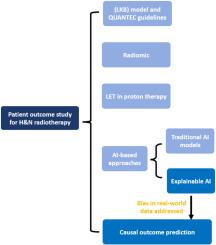Critical review of patient outcome study in head and neck cancer radiotherapy
引用次数: 0
Abstract
In modern radiation therapy for head and neck cancers, the treatment related toxicities remain a significant clinical challenge. This review critically evaluates the evolution of data-driven approaches in predicting patient outcomes in head and neck cancer patients treated with radiation therapy. Three transformative methodological advances are reviewed: radiomics, AI-based algorithms, and causal inference frameworks. The integration of linear energy transfer in patient outcomes study, which has uncovered critical mechanisms behind unexpected toxicity, was also introduced for proton therapy. While radiomics has transformed medical image analysis through comprehensive quantitative characterization, AI models have demonstrated markedly superior predictive capabilities over traditional approaches, offering promising avenues for personalized radiation therapy with reduced toxicity profiles. However, the field faces significant challenges in translating statistical correlations from real-world data into interventional clinical insights. We highlight how causal inference methods can bridge this gap by providing a rigorous framework for identifying treatment effects. Looking ahead, we envision that combining these complementary approaches, especially the interventional prediction models, will enable more personalized treatment strategies, ultimately improving both tumor control and quality of life for head and neck cancer patients treated with radiation therapy.

头颈癌放疗患者预后研究综述
在头颈部癌症的现代放射治疗中,治疗相关的毒性仍然是一个重大的临床挑战。本综述批判性地评估了数据驱动方法在预测头颈癌放疗患者预后方面的发展。回顾了三种变革性的方法进展:放射组学,基于人工智能的算法和因果推理框架。线性能量转移在患者预后研究中的整合,揭示了意外毒性背后的关键机制,也被引入质子治疗。虽然放射组学通过全面的定量表征改变了医学图像分析,但人工智能模型已经显示出比传统方法明显优越的预测能力,为降低毒性的个性化放射治疗提供了有希望的途径。然而,该领域在将现实世界数据的统计相关性转化为介入性临床见解方面面临着重大挑战。我们强调因果推理方法如何通过提供一个严格的框架来确定治疗效果,从而弥合这一差距。展望未来,我们设想结合这些互补的方法,特别是介入预测模型,将实现更个性化的治疗策略,最终改善肿瘤控制和头颈癌患者接受放射治疗的生活质量。
本文章由计算机程序翻译,如有差异,请以英文原文为准。
求助全文
约1分钟内获得全文
求助全文

 求助内容:
求助内容: 应助结果提醒方式:
应助结果提醒方式:


